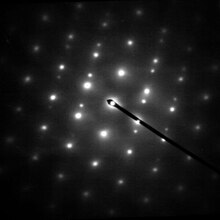
Electron diffraction refers to both the electron matter wave diffraction phenomenon and its many applications, especially to crystallography. When suitably prepared electrons encounter crystalline solids striking diffraction patterns emerge – see Figure 1; analysis of these patterns provide deep insight into the atomic structure of the solid. Electron diffraction also occurs whenever electron matter waves encounter obstacles, such as a plate with two slits in the double slit experiment.
Electron diffraction resembles x-ray and neutron diffraction technologies but with complementary strengths and areas of application. Electron diffraction from atoms occurs due to elastic scattering, when there is no change in the energy of the electrons during their interactions with atoms.[1][2][3] The negatively charged electrons are scattered due to Coulomb forces when they interact with both the positively charged atomic core and the negatively charged electrons around the atoms; most of the interaction occurs quite close to the atoms, within about one angstrom. In comparison, x-rays are scattered after interactions with the electron density while neutrons are scattered by the atomic nuclei through the strong nuclear force.
End sandbox content for Electron Diffraction Comments edit
DO NOT USE: Some references to make bot happy
The magnitude of the interaction of the electrons with a material scales as[1] [2] [3]
References edit
- ^ a b John M., Cowley (1995). Diffraction physics. Elsevier. ISBN 0-444-82218-6. OCLC 247191522.
- ^ a b Reimer, Ludwig (2013). Transmission Electron Microscopy : Physics of Image Formation and Microanalysis. Springer Berlin / Heidelberg. ISBN 978-3-662-13553-2. OCLC 1066178493.
- ^ a b Colliex, C.; Cowley, J. M.; Dudarev, S. L.; Fink, M.; Gjønnes, J.; Hilderbrandt, R.; Howie, A.; Lynch, D. F.; Peng, L. M. (2006), Prince, E. (ed.), "Electron diffraction", International Tables for Crystallography, vol. C (1 ed.), Chester, England: International Union of Crystallography, pp. 259–429, doi:10.1107/97809553602060000593, ISBN 978-1-4020-1900-5